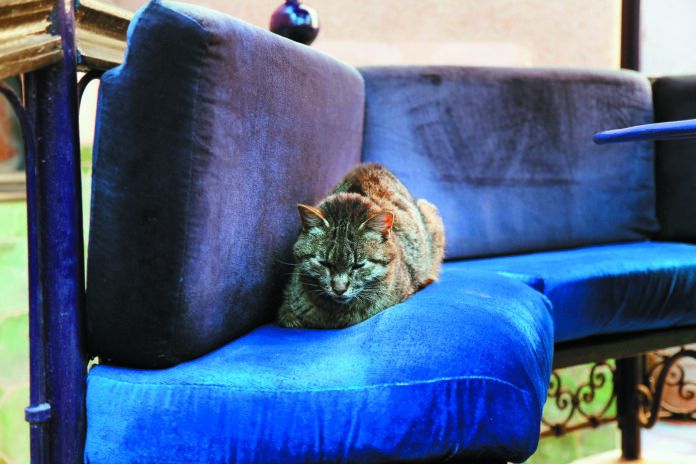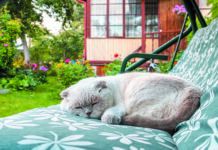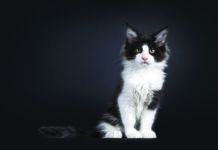You might think that with a cat in the house, nubby fabrics are best for covering your upholstery. If your cat sinks her claws into them, the reasoning goes, the scratches won’t show as much. But it doesn’t go that way. Cats are especially attracted to highly textured fabric for giving their nails a good workout; they’ll happily rip such fabric to shreds. That’s why interior designers recommend going with smooth fabrics. They will make a cat more likely to leave the scratching to the scratching post.
There are actually a number of tips for accommodating your cat’s proclivities while keeping your home from looking like the morning after a party at a feline fraternity house. Granted, the end result probably won’t be your idea of design perfection. As more than one designer has aptly put it, our pets are our roommates. They’re great to have as live-in buddies, but you just have to let some things go.
Here’s some advice on making your home comfortable for your cat while keeping it from becoming an eyesore for you.
Feline-friendly furniture fabric. A number of design mavens recommend velvet, ultra suede, or leather for couches and chairs. They don’t leave much for a cat’s claws to catch onto.
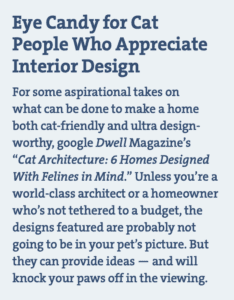 It’s not that you’re never going to get a scratch in leather or velvet, and you still have to trim your cat’s nail regularly for the best outcome. But smooth fabrics are less likely to end up shredded (which is why you also shouldn’t go for seat backs or sides with caning, dining chair seats made of rope, or sisal rugs).
It’s not that you’re never going to get a scratch in leather or velvet, and you still have to trim your cat’s nail regularly for the best outcome. But smooth fabrics are less likely to end up shredded (which is why you also shouldn’t go for seat backs or sides with caning, dining chair seats made of rope, or sisal rugs).
Designers also recommend colormatching, or at least color-coordinating, your decor with your cat. It may sound far-fetched, but your cat is going to be with you for 15, 20, or more years. Do you really want to be trying to deal with black fur on a white couch into the 2040s?
You can’t always perfectly color coordinate. After all, unless you’re the Addams family, you’re probably not going to want to completely deck your family room in black sofas, love seats, and floor coverings to accommodate your black cat’s shedding. But you might feel okay with deep blues and other rich colors. And if you have a ginger-colored cat or a tabby, earth tones can help hide the hair.
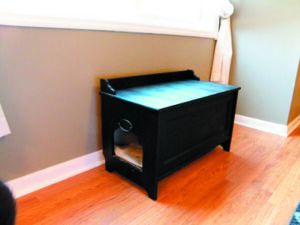

Litter box-holding furniture. Like you, cats want their litter boxes away from the action. But they still want them easy to access rather than perhaps down in the basement or somewhere else that’s inconvenient to get to. What about creating a litter box cabinet? Some people cut out the side of a cabinet, solid bench, or nightstand for the cat to use as a doorway, with the litter box inside. It blends right in with their home decor. They keep it in the mudroom or in the bathroom if there’s space. That way, the cat can get there easily when the urge to eliminate strikes but do her business in privacy even if you’re right nearby. Plus, you don’t have to look at the litter box every time you pass through.
There are those who even carve out a door at the bottom of a closet with the litter box just inside. It may be a closet in the laundry room or bathroom, for instance.
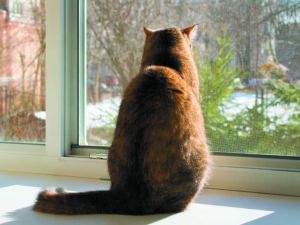

The bigger the window, the better.
Windows on the world. A cat can’t have too many windows. Not only the more the better, but also, the larger the better. Is it possible to add more windows to your home, or to enlarge a couple of the ones that are already there? Might you be able to replace an existing window with a series of windows that arc away from the house in a semi-circle or other shape and have a wide sill for the cat to sit on?
If you’re a cat person who’s building a new home, now’s the time to have it designed with as many windows as possible. You won’t mind the extra light, either, and of course you can draw the shades or curtains whenever you desire privacy.
Stairway to heaven. It’s heavenly for a cat to be up high, and one way to allow that to happen without interrupting your design sense is to build a series of stepped cabinets along a wall. Each one can be a little higher than the next so that your cat has several perches to choose from as she climbs from lowest to highest.
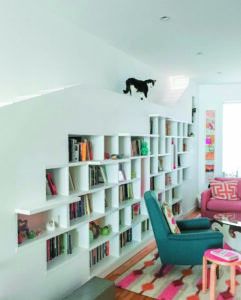

You can add doors to the front of stepped cabinets to step up your design.
The cabinets don’t need to cut significantly into your floor space. Even cabinets that are only about eight or nine inches deep can be used to store things that you want kept out of sight. If you want, you can choose doors for the cabinets whose style is dictated by your decor.
Got an antique home? Use Shaker-style doors. Something contemporary? Install flat doors that have a matte (or glossy) finish and no handles. There are touch-open doors and ones with a small groove that you use to pull the door toward you. You can also leave some of the cabinets open with shelving for books and knick-knacks.

